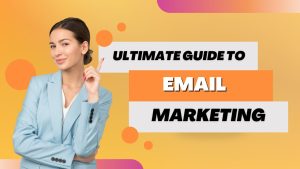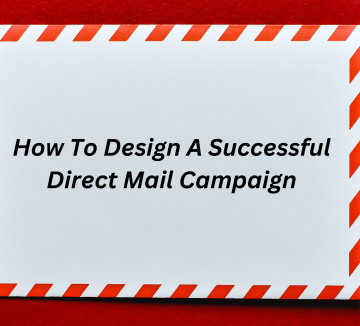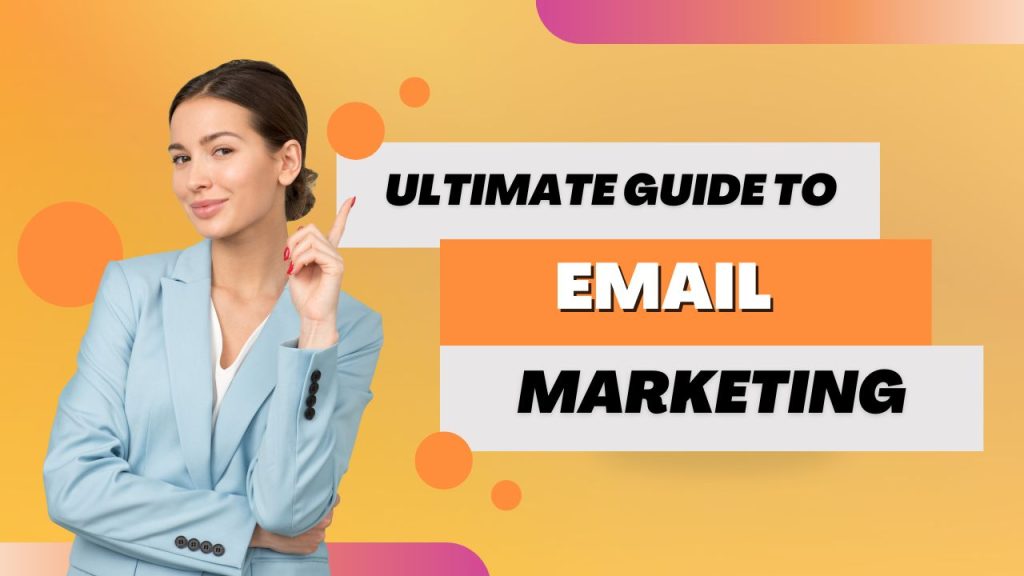Last Updated on May 4, 2023 by David
Email marketing has been a staple in the digital marketing world for decades. It remains one of the most effective ways for businesses of all sizes to connect with their audiences.
From building your email list to crafting effective emails, automating your campaigns, measuring success, and implementing advanced strategies, this guide will cover everything you need to know to create successful email marketing campaigns that drive conversions and increase revenue.
You may also like:
- Harnessing the Power of Tag Clouds for SEO
- How To Design A Successful Direct Mail Campaign
- Lead Nurturing 101: Convert More Leads into Customers
What is Email Marketing?
Email marketing is the process of sending commercial messages to a group of people via email. It’s one of the most effective and affordable forms of digital marketing, and it’s used by businesses of all sizes to reach and engage their target audience.
Email marketing is important because it allows businesses to communicate with their audience directly.
With email marketing, businesses can reach their subscribers with personalized messaging that’s tailored to their interests and needs.
This makes it a highly effective way to build relationships with customers and drive sales.
How can Email Marketing Benefit Your Business?

Email Marketing 101
Email marketing can benefit your business in several ways:
- Email Marketing Helps Businesses Increase Sales
Email marketing is an effective way for businesses to reach out to their customers and prospects via email to promote their products or services, build relationships, and increase sales.
Here are some ways in which email marketing can help businesses achieve increased sales:
Build Relationships: Email marketing enables businesses to build and maintain relationships with their customers by sending personalized and relevant content that speaks to their interests, needs, and preferences.
This helps to establish trust and credibility, which can lead to increased sales.
Targeted Marketing: With email marketing, businesses can segment their email list based on various factors such as demographics, purchase history, and interests.
This enables businesses to send targeted emails to specific groups of customers, which increases the likelihood of making a sale.
Promote Offers: Email marketing provides businesses with the ability to promote special offers, discounts, and promotions to their customers, which can lead to increased sales.
This is particularly effective when the offers are exclusive to email subscribers, creating a sense of urgency and exclusivity.
Upsell and Cross-sell: Email marketing can be used to promote complementary products or services to customers who have already made a purchase.
This is an effective way to upsell and cross-sell, leading to increased sales and revenue.
Track and Measure Results: Email marketing platforms provide businesses with analytics and data on their email campaigns, including open rates, click-through rates, and conversion rates.
This information can be used to optimize future campaigns for increased sales and better ROI.
Email marketing is a powerful tool for businesses to connect with customers, promote products and services, and increase sales.
By delivering personalized and relevant content, targeting specific groups of customers, promoting exclusive offers, and analyzing campaign results, businesses can achieve increased sales and better ROI through email marketing.
- Email Marketing Helps Achieve Customer Retention
Email marketing can be a powerful tool for businesses to retain customers by keeping them engaged and informed.
Here are some ways in which email marketing can help businesses achieve customer retention:
Personalized Communication: Email marketing allows businesses to communicate personally with their customers.
Ideally, addressing customers by name and tailoring the message to their interests and needs can help them feel valued and appreciated, leading to increased loyalty and repeat business.
Timely and Relevant Content: By sending targeted emails to customers, businesses can provide timely and relevant content tailored to their interests and needs. This can include special promotions, discounts, or new product launches, which can help keep customers engaged and interested in the business.
Consistent Brand Messaging: Email marketing can help businesses maintain consistent brand messaging by using the same tone, voice, and imagery across all communications.
This can help customers feel more connected to the brand and can reinforce their loyalty over time.
Feedback and Engagement: Email marketing can also be used to solicit customer feedback and encourage them to engage with the business through surveys, reviews, and social media.
This helps businesses identify areas for improvement and address customer concerns, which can lead to increased loyalty and retention.
Automated Workflows: Automated email workflows can be set up to target customers at specific stages of the customer journey, such as after a purchase or when a subscription is due for renewal. This can help businesses stay in touch with their customers and provide them with relevant information and offers to encourage repeat business.
Email marketing can be an effective tool for businesses to achieve customer retention by keeping their existing customers engaged, informed, and valued.
Businesses can foster customer loyalty and increase retention over time by providing timely and relevant content, personalized communication, and consistent brand messaging.
- Email Marketing Helps Attain Brand Awareness
Email marketing is a powerful tool businesses can use to increase brand awareness among their target audience. Here are some ways in which email marketing can help businesses achieve this goal:
Consistent Branding: Using consistent branding throughout your email campaigns can help your audience become more familiar with your brand.
This can be achieved by including your brand logo, colors, and tone of voice in your emails.
Personalized Emails: Personalized emails have been shown to be more effective than generic ones in engaging subscribers.
By addressing subscribers by their name and tailoring the content of your emails to their interests, you can create a more personalized experience that strengthens the connection between your brand and your audience.
Shareable Content: Creating shareable content in your emails can help extend your brand’s reach beyond your current subscribers. This can be achieved by including social media buttons, encouraging subscribers to forward the email to friends, and including links to your website or blog.
Consistent Email Campaigns: Consistent email campaigns can help keep your brand at the forefront of your subscribers’ minds.
You can create a stronger brand identity by regularly sending emails that provide value to your subscribers, such as new product releases, promotions, or industry news.
Segmented Email Lists: By segmenting your email lists based on subscriber interests, demographics, and behavior, you can create more targeted and relevant email campaigns.
This can help increase engagement and build stronger connections between your brand and audience.
Email marketing can help businesses achieve brand awareness by providing their subscribers a consistent, personalized, and engaging experience. By using the right strategies, businesses can build a stronger brand identity and establish long-lasting relationships with their audience.
Understanding the Anatomy of a Successful Email Campaign
To create a successful email campaign, it’s important to understand the key components that make up a successful email.
Here’s a breakdown of the anatomy of a successful email campaign:
- A Clear Goal: Before you start creating your email campaign, it’s important to have a clear goal in mind. Your goal should be specific, measurable, and relevant to your business.
- A Targeted Audience: Your email campaign should be targeted to a specific segment of your audience. This will help ensure that your messaging is relevant and engaging to your subscribers.
- Engaging Content: Your email content should be engaging, informative, and relevant to your audience. It’s important to write in a conversational tone that resonates with your subscribers and encourages them to take action.
- A Strong Call-to-Action (CTA): Your call-to-action (CTA) is the action you want your subscribers to take after reading your email. A strong CTA can significantly improve your conversion rates and drive more sales.
Email Marketing Techniques for Small Businesses
Email marketing can be a highly effective tool for small businesses, but it’s important to use the right techniques to succeed. Here are some email marketing techniques that small businesses can use to achieve success:
- Start Building Your Email List
Email marketing has become an essential component of digital marketing and is an effective tool for small businesses to communicate with their target audience.
Building a targeted email list is one of the most critical steps in developing an effective email marketing campaign.
This list should consist of engaged, interested subscribers that are more likely to convert.
In this section, we will explore how to build a targeted email list, including the importance of email marketing, capturing leads with opt-in forms and pop-ups, creating compelling lead magnets, designing a high-converting landing page, and segmenting your email list.
The Importance of Building an Email List
Building an email list is crucial for any business looking to expand its digital marketing efforts. There are several reasons why building an email list is essential:
- Direct communication with your target audience
Email marketing allows businesses to communicate directly with their target audience. Unlike social media or other digital marketing channels, email provides a more personal and direct form of communication.
This direct line of communication enables businesses to build stronger relationships with their subscribers, which can lead to increased engagement and higher conversion rates.
- Increased return on investment (ROI)
Email marketing has a higher ROI compared to other digital marketing channels.
According to the Direct Marketing Association, email marketing has an average ROI of $42 for every $1 spent.
This is because email marketing allows businesses to target their audience more precisely and create more personalized and relevant content.
- Gives Your Business Greater Control Over Your Marketing Efforts
Building an email list gives businesses greater control over their marketing efforts. With email marketing, businesses can segment their email list based on various factors such as location, behavior, or demographics.
This segmentation allows businesses to create more targeted and relevant content, resulting in higher engagement rates.
- Increased website traffic
Email marketing can also help drive more traffic to your website. By including links to your website in your email campaigns, businesses can drive more traffic to their website, resulting in increased visibility and potentially higher sales.
- Cost-effective marketing
Email marketing is one of the most cost-effective marketing channels. There are several email marketing tools available that are affordable for small businesses. These tools allow businesses to create professional-looking email campaigns that are easy to design and send.
Building an email list is crucial for businesses looking to expand their digital marketing efforts. Email marketing provides direct communication with your target audience, resulting in higher engagement and conversion rates.
In addition, Building an email list also provides greater control over your marketing efforts, increased website traffic, and is a cost-effective marketing channel.
- Capture Leads with Opt-In Forms and Pop-Ups
Opt-in forms and pop-ups effectively capture leads and build your email list. To effectively capture leads, businesses should follow these best practices:
- Create a compelling offer
You must create a compelling offer to increase the likelihood of visitors subscribing to your email list.
The offer should provide value to your audience and address their pain points. For example, you can offer a free e-book, discount code, or access to exclusive content.
- Place opt-in forms and pop-ups strategically.
Opt-in forms and pop-ups should be strategically placed on your website or landing pages.
They should be placed where visitors are most likely to engage with them.
For example, you can place an opt-in form at the end of a blog post or a pop-up on the homepage.
- Keep it simple
Opt-in forms and pop-ups should be simple and straightforward. Visitors should be able to understand the offer and know what they are signing up for.
Avoid using confusing or technical language that may discourage visitors from subscribing.
- Use eye-catching visuals
Opt-in forms and pop-ups should be visually appealing and eye-catching. They should use colors and images that align with your brand and grab the visitor’s attention.
- Use email marketing tools.
Email marketing tools such as Sumo, OptinMonster, or Thrive Leads can help you create eye-catching opt-in forms and pop-ups that integrate with your email marketing platform.
These tools provide customizable templates that can be tailored to your brand and message.
Opt-in forms and pop-ups are powerful tools for capturing leads and building your email list.
By creating a compelling offer, placing opt-in forms and pop-ups strategically, keeping it simple, using eye-catching visuals, and utilizing email marketing tools, businesses can increase the likelihood of visitors subscribing to their email list.
- Create Compelling Lead Magnets to Attract Subscribers
Lead magnets are an effective way to attract subscribers to your email list.
A lead magnet is a valuable resource you offer your target audience in exchange for their email address.
Lead magnets can be anything from e-books, whitepapers, checklists, templates, webinars, or any other valuable content your target audience finds useful.
Here are some tips for creating a compelling lead magnet that will attract subscribers to your email list:
- Focus on solving a problem
Your lead magnet should focus on solving a problem for your target audience.
By solving a problem they face, you will increase the perceived value of your lead magnet and encourage more people to subscribe to your email list.
For example, a lead magnet could be a workout plan or a healthy eating guide if you run a health and fitness blog.
- Offer specific, actionable advice
Your lead magnet should offer specific, actionable advice that your target audience can implement right away.
This will help to establish your authority in your niche and increase the likelihood of your subscribers engaging with your content.
For example, a lead magnet could be a social media advertising checklist if you run a digital marketing agency.
- Use visual elements
Visual elements can make your lead magnet more appealing and increase engagement rates.
Use high-quality images, infographics, and charts to make your lead magnet more visually appealing and easier to understand.
Visuals can also help to break up the text and make your content more scannable.
- Keep it concise
Your lead magnet should be concise and to the point. Avoid long, drawn-out explanations or excessive details.
Your target audience is likely busy and needs more time to read a lengthy guide or e-book.
Keep your lead magnet short but packed with value.
- Make it easy to consume
Your lead magnet should be easy to consume. Consider the format that your target audience would prefer, and create your lead magnet in that format.
For example, if your target audience is busy entrepreneurs, a short, actionable video may be more effective than a lengthy e-book.
Lead magnets are a great way to attract subscribers to your email list.
By focusing on solving a problem for your target audience, offering specific, actionable advice, using visual elements, keeping it concise, and making it easy to consume, you can create a compelling lead magnet that will encourage more people to subscribe to your email list.
4. Craft Effective Emails
Emails are essential to modern communication, used for everything from business correspondence to personal communication.
However, not all emails are created equal, and crafting an effective email requires careful consideration of various factors, including the type of email, the subject line, the body copy, the visual design, and the call to action.
This section will explore these elements in depth to provide a comprehensive guide for crafting effective emails.
- Understand the Different Types of Emails
The first step in crafting an effective email is understanding the different email types and their purposes.
There are several types of emails, including:
- Transactional Emails: These are automated emails sent in response to a user’s action, such as a confirmation email after a purchase or a password reset email.
- Promotional Emails: These are marketing emails sent to promote a product, service, or event.
- Newsletter Emails: These are regular emails sent to subscribers with updates, news, and other information.
- Personal Emails: These are emails sent for personal communication, such as catching up with a friend or family member.
Understanding the type of email you are writing will help you determine the appropriate tone, structure, and content.
- Write Subject Lines that Get Your Emails Opened
The subject line is the first thing your recipient sees, and it can make or break whether they decide to open your email. To write effective subject lines, keep the following tips in mind:
- Keep it Short and Sweet: Aim for a subject line that is 6-10 words in length.
- Be Specific: Use specific language that accurately reflects the content of the email.
- Use Action Words: Verbs like “Discover,” “Learn,” or “Explore” can make your subject line more engaging.
- Personalize it: Including the recipient’s name can increase the likelihood of your email being opened.
- Avoid Spam Trigger Words: Words like “Free,” “Urgent,” or “Limited Time” can trigger spam filters and cause your email to be marked as spam.
Focus On Writing Engaging Email Copy
Once your recipient has opened your email, the body copy will keep them engaged. Here are some tips for writing engaging email copy:
- Know Your Audience: Write your email with your target audience in mind.
- Keep it Short: People have short attention spans, so keep your email concise and to the point.
- Use a Conversational Tone: Write as if you are having a conversation with the recipient.
- Use Emotion: Emotion can make your email more engaging, whether it’s humor, excitement, or empathy.
- Include a Call-to-Action: Encourage your reader to take action, such as clicking a link or replying to the email.
Best Practices for Designing Visually Appealing Emails
In addition to the content of your email, the design can also impact its effectiveness. Here are some best practices for designing visually appealing emails:
- Keep it Simple: A simple, clean design is often more effective than a cluttered one.
- Use Visual Hierarchy: Use size, color, and placement to create a clear visual hierarchy.
- Be Consistent: Use consistent branding and design elements throughout your email.
- Optimize for Mobile: Many people read emails on their mobile devices, so make sure your email is optimized for mobile viewing.
- Use High-Quality Images: Use high-quality images relevant to your email’s content.
Conclusion
Email marketing is a powerful tool for businesses of all sizes, and when done correctly, it can drive significant results.
Following the tips and strategies outlined in this guide, you can build a targeted email list, craft effective emails, automate your campaigns, measure your success, and implement advanced strategies that drive conversions and increase revenue.
Remember, email marketing is a continuous testing, optimization, and improvement process.
By staying up-to-date with the latest trends and best practices, you can ensure that your email marketing campaigns always drive results for your business. So, get started today and take your email marketing to the next level!
Email marketing has proven to be highly effective, with high open and click-through rates, and a strong return on investment (ROI). It allows for personalized communication and engagement with subscribers, making it a valuable tool for businesses to reach their audience and achieve their marketing goals.
Best practices for email marketing include using a clear and compelling subject line, personalizing emails, segmenting your audience, optimizing email content for mobile devices, and providing valuable and relevant content to subscribers. Regularly testing and analyzing email campaigns can help optimize performance.
Building an email list involves various strategies such as creating compelling opt-in forms on your website, offering incentives for sign-ups, utilizing social media, and leveraging offline events. It’s important to follow relevant regulations and obtain permission from subscribers to comply with email marketing laws.
To improve email open rates, you can try using personalized subject lines, avoiding spammy language, segmenting your audience, and sending emails at optimal times. A/B testing subject lines and monitoring open rates can help identify effective strategies to improve engagement.
Tips for writing effective email content include being concise, using engaging language, addressing the needs and interests of your audience, using a conversational tone, and including a clear call-to-action. Segmenting your audience and personalizing content can also increase engagement.
Optimizing emails for mobile devices involves using responsive email templates, using a single-column layout, using clear and legible fonts, and including mobile-friendly CTAs. Testing your emails on various mobile devices and email clients can also help ensure a seamless experience for mobile users.




